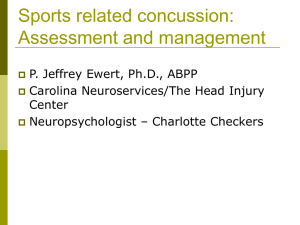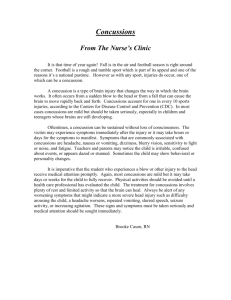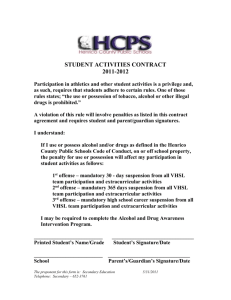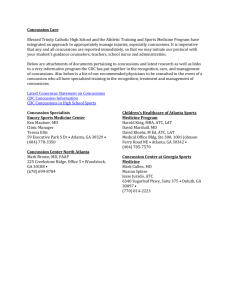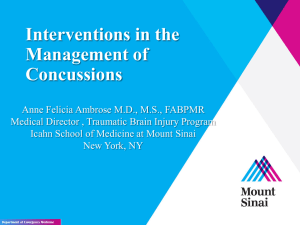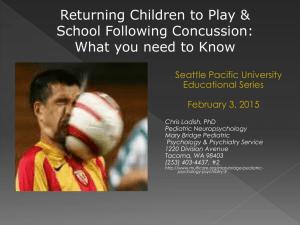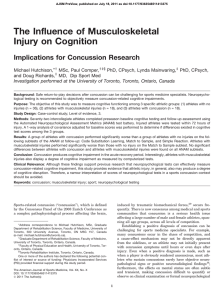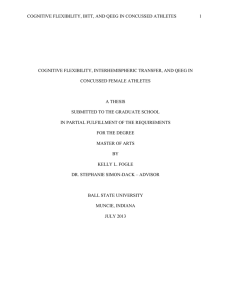Concussion Powerpoint
advertisement
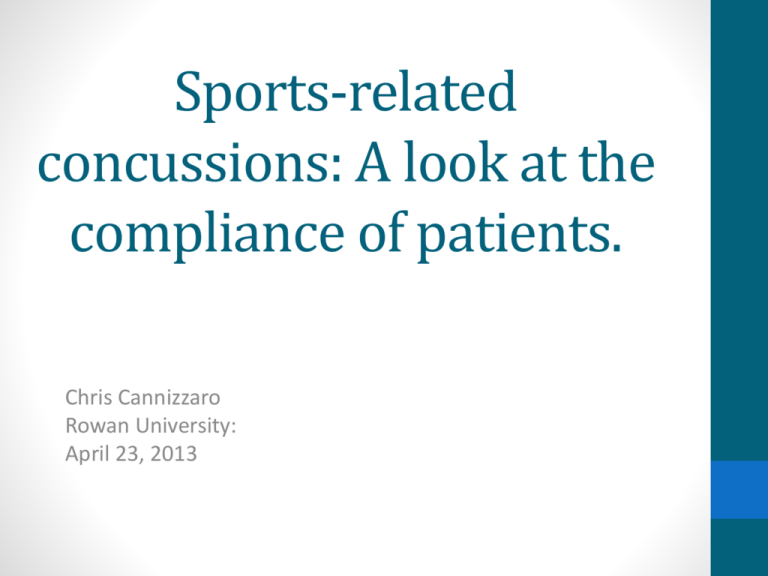
Sports-related concussions: A look at the compliance of patients. Chris Cannizzaro Rowan University: April 23, 2013 Introduction • Concussions have received an increasing amount of attention in recent years, especially in relation to sports. • Typical signs and symptoms include: • • • • physical, cognitive, visual and emotional symptoms • If proper treatment is not followed by a patient, the symptoms of a concussion can last far longer than suspected and as cause lasting damage (Serruya & Franks 2014). Background Literature • McGrath, Dinn, Collins, Lovell, Elbin, and Kontos (2013) studied 54 student-athletes who have had a baseline test performed within the past 2 years and incurred a sport-related concussion. • It has been recommended that athletes do not return to play until they are both free of symptoms and their neurocognitive test results have returned to pre-injury baseline levels. • 27.7% of concussed student-athletes who were symptom-free returned to their baseline on the ImPACT test at rest, however following moderate physical exertion the results showed cognitive decline (McGrath et al, 2013). Goal of Study & Hypothesis • The current study will investigate whether or not activity level during the recovery period results in slower recovery. • Furthermore, this study aims to disentangle the effect of cognitive verses physical activity. • Hypothesis: • I predict that the less physical and cognitive activity the patient participates in, the shorter the healing time will be and it will help the patient return to baseline more rapidly. Methods • The standard of care restricts all physical and cognitive activity preceding a concussion in order to recover properly. • The problem with this is getting patients to adhere these restrictions. • In this quasi-experiment, we will look at three levels of our independent variable, restriction level of physical and cognitive activity. Participants • Participants will be recruited throughout one collegiate athletic year, from August until June. • Upon seeking treatment for a concussion the participants will be asked if they are willing to participate in a study that focuses on the effects of concussion treatment. • This study aims to recruit about 50 participants, however will be based on a convince sample as it is not possible to predict how many concussion injuries will occur throughout the year. Participants continued • Inclusion criteria: • Collegiate athletes ages 18-22 who have suffered a concusion. • Exclusion Criteria: • had prior concussions, • heavy alcoholic drinkers, • or have any prior neurological/ cognitive impairments. Design • Quasi-Experimental • Non-equivalent group design • Time-series design Independent Variable & Dependent Variable • 3 levels of the Independent Variable: • 1. A group who reports to have followed the doctor’s orders and restricted all cognitive and physical activity, • 2. A group who reports that they did mild cognitive activity despite the doctors’ orders, and • 3. A group who reports that they did some physical activity despite the doctor’s orders • Dependent Variable: • The time that it takes each participant to reach their level of baseline. Procedure • The participants’ concussive symptoms will be measured using the ImPACT® (Immediate Post-Concussion Assessment and Cognitive Testing). • Using non-equivalent groups (dependent upon the level of restriction) and • Time series design, we will attempt to determine the best level of treatment of concussions. In the past 3 days how many hours have you: More than 3 hours 1-2 hours None Read a book? Watched TV? Gone on your cellphone? (texting, social media, etc.) Gone on your computer? (email, social media, etc.) Worked out? Got your heart rate above normal for your age? Become stressed? Done schoolwork? Do you believe it is important to restrict your cognitive and physical activity as directed by your doctor? ( yes / no ) ImPACT results Day 1 Day 4 Day 7 Day 10 Day 13 Survey Results -> Level of restriction Strengths • Collegiate athletes were chosen because the NCAA to receive a baseline test prior to each season, so there is a great baseline to compare to. • The study has high internal validity and can be useful in determining the best plan of action for these patients who receive concussions most frequently. • While athletes seem to have the highest frequency of concussions, it is an great starting point for a study like this. • The use of the ImPACT test. Using this test helps to ensure valid results. Limitations • Only testing individuals currently enrolled in college, ages 1823, and participating in a college level sport. • The study may have limited external validity to the general public.. Thank you for your kind attention References • Master, E.J.T, Kessels, A.G., Leak, M.D., Jordan, B.D., Troost, J. (1999). Neurological impairment in amateur soccer players. American Medical Association, 182, 971-973. • McGrath, N., Dinn, W. M., Collins, M. W., Lovell, M. R., Elbin, R. J., & Kontos, A. P. (2013). Post-exertion neurocognitive test failure among student-athletes following concussion. Brain Injury, 27(1), 103-113. doi:10.3109/02699052.2012.729282 • Moser, R., Glatts, C., & Schatz, P. (2012). Efficacy of immediate and delayed cognitive and physical rest for treatment of sportsrelated concussion. The Journal of Pediatrics, 161(5), 922-926. doi:10.1016/j.jpeds.2012.04.012 • Serruya, M., & Franks, R. (2014). Comprehensive concussion center. Retrieved from http://www.jeffersonhospital.org/ departments-and-services/comprehensive-concussioncenter/_vsrefdom=neuro_search&gclid=CL6Kx4S6u70CFeMSOgod4C MA9Q


